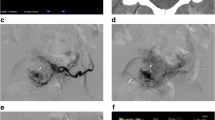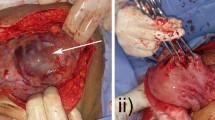Abstract
Background
At cesarean hysterectomy for abnormally invasive placenta, rupture of aberrant vessels around the uterus causes massive bleeding.
Purpose
This study aimed at describing a technique to reduce bleeding from aberrant vessels at the posterior bladder wall in this surgery.
Methods
The bladder is filled with 200–300 mL of water during handling the posterior bladder wall.
Results
This technique facilitates understanding that some aberrant vessels do not have communications with the cervix-uterus. Some aberrant vessels have communication with the cervix-uterus and this technique makes cutting and ligation of these vessels easy.
Conclusions
Filling the bladder may reduce bleeding from the posterior bladder wall at cesarean hysterectomy for abnormally invasive placenta.

Similar content being viewed by others
Abbreviations
- AIP:
-
Abnormally invasive placenta
References
Wei Y, Cao Y, Yu Y, Wang Z (2017) Evaluation of a modified “Triple-P” procedure in women with morbidly adherent placenta after previous caesarean section. Arch Gynecol. doi:10.1007/s00404-017-4447-0 (Epub ahead of print)
Sentilhes L, Goffinet F, Kayem G (2013) Management of placenta accreta. Acta Obstet Gynecol Scand 92(10):1125–1134
Matsubara S, Kuwata T, Usui R, Watanabe T, Izumi A, Ohkuchi A, Suzuki M, Nakata M (2013) Important surgical measures and techniques at cesarean hysterectomy for placenta previa accreta. Acta Obstet Gynecol Scand 92(4):372–377
Matsubara S (2013) Caesarean hysterectomy for placenta praevia accreta: filling the bladder technique to identify an appropriate bladder separation site. J Obstet Gynaecol 33(2):163–164
Palacios Jaraquemada JM, Pesaresi M, Nassif JC, Hermosid S (2004) Anterior placenta percreta: surgical approach, hemostasis and uterine repair. Acta Obstet Gynecol Scand 83(8):738–744
Author information
Authors and Affiliations
Contributions
Shigeki Matsubara, Hironori Takahashi, and Yosuke Baba identified the significance, and wrote and edited the manuscript.
Corresponding author
Ethics declarations
Conflict of interest
Shigeki Matsubara, Hironori Takahashi, and Yosuke Baba declare that they have no conflict of interest.
Human rights
This article does not contain any studies with human participants or animals performed by Shigeki Matsubara, Hironori Takahashi, or Yosuke Baba.
Rights and permissions
About this article
Cite this article
Matsubara, S., Takahashi, H. & Baba, Y. Handling aberrant vessels located in the posterior bladder wall in surgery for abnormally invasive placenta: a non/less-touch technique. Arch Gynecol Obstet 296, 851–853 (2017). https://doi.org/10.1007/s00404-017-4498-2
Received:
Accepted:
Published:
Issue Date:
DOI: https://doi.org/10.1007/s00404-017-4498-2




